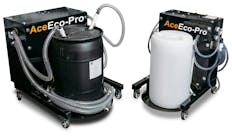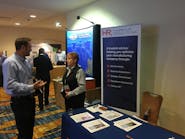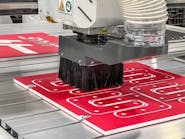Alliance robotic laser welding system automates tool repair
By Bruce Geiselman
Alliance Specialties and Laser Sales has paired a solid-state laser welder with a Universal Robots cobot to offer a new welding system that can be used in both manual and automated modes for a variety of tasks including mold repair.
The Alliance ID1-UR Robotic Fiber Laser system employs a Universal Robots UR10e cobot with a six-axis robot arm. It can be controlled with a joystick, a UR pendant or via automated programming. It comes standard with 300 watts of fiber laser power, and also is available with more-powerful 450-watt and 600-watt lasers, giving plastics processors the ability to weld virtually any tooling material including tool steel, stainless steel, carbon steel, titanium, aluminum, nickel and copper, according to the company.
Scott Erickson, senior R&D laser process engineer with Alliance, demonstrated the ID1-UR at the Universal Robots booth at NPE2024.
When molds are damaged during production, the damaged areas can be filled using a filler wire and a laser welder.
“With the heat from the laser, you’re going to melt that wire and fill that area,” Erickson said. “After that, it gets ground off, machined and polished. The unique thing about a laser on the end of a robot [arm] is that you can get into different angles. You can adjust your power levels, follow contours and build up areas on the mold.”
The 450-watt laser is adequate for most mold repair operations. However, a user might want a higher-power laser if using thicker filler wire (greater than 0.4 inches) on a cavity for a large repair or buildup, according to the company. A higher-power laser also might be appropriate when welding or filling highly reflective materials including aluminum, copper, silver, gold or other precious metals. Automated welding applications where higher weld speeds are required might also warrant a high-powered laser, according to a company statement.
Operators typically will use the joystick to control the welder for most mold repair operations. However, sometimes defects can develop repeatedly in the same area of a mold. In those cases, an operator could put the mold into a fixture and then program the cobot to perform the repairs automatically. The cobot can also be programmed for quick injection mold prototyping, changes and modifications. It also has the flexibility to perform other manual or automated welding tasks that a plastics processor might need in the shop environment.
The UR cobot can be manipulated in any angle, direction, rotation or hard-to-reach areas. “You could go back and forth between automatic and manual,” Erickson said. “Mostly, these kinds of collaborative robots are used for pick-and-place and palletizing, things like that. We’re actually using it as a different type of a tool.”
The robotic laser welding system is available on wheels so that it can easily be moved around the shop floor to conduct repairs in different areas. Or, it could be kept stationary sitting next to a welding table in a shop area.
The ID1-UR1 is Alliance’s newest variant of its original ID1 mold repair machine, which is operated manually and is limited to three axes of cartesian motion, according to the company. The original ID1 was introduced about 20 years ago.
Alliance Specialties and Laser Sales, Wauconda, Ill., 847-487-1945, www.alliancelasersales.com
Bruce Geiselman | Senior Staff Reporter
Senior Staff Reporter Bruce Geiselman covers extrusion, blow molding, additive manufacturing, automation and end markets including automotive and packaging. He also writes features, including In Other Words and Problem Solved, for Plastics Machinery & Manufacturing, Plastics Recycling and The Journal of Blow Molding. He has extensive experience in daily and magazine journalism.






